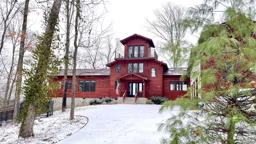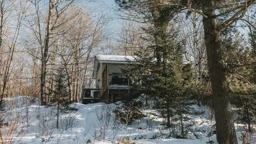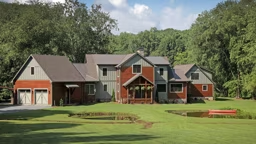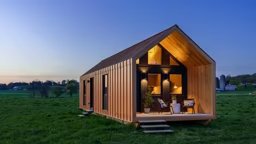If you’ve ever read the “Little House on the Prairie” series, you’ll probably remember detailed passages of Pa building log cabins for the family. It was always a frantic rush just ahead of the winter winds, felling and notching trees with simple hand tools. There would be the occasional help of a kindly frontier neighbor, some assistance from Ma (until she was injured in the process), but mostly it was man versus wilderness in a battle of survival.
Survival wasn’t much of a factor for Doug Vukson’s family when they hand-built a cabin on an upper Midwestern lake – that is, if you don’t count the mosquitoes. However, there certainly was mental strain to consider. “We had the whole family living in a tent all weekend, every weekend for two summers,” says Doug. That was a lot of pressure for a guy who had never even built a birdhouse.
Survival wasn’t much of a factor for Doug Vukson’s family when they hand-built a cabin on an upper Midwestern lake – that is, if you don’t count the mosquitoes. However, there certainly was mental strain to consider. “We had the whole family living in a tent all weekend, every weekend for two summers,” says Doug. That was a lot of pressure for a guy who had never even built a birdhouse.
A Dream & A Scribe
It started back in the early 1980s when Doug went to log building school with a friend. “We were bad students,” he confesses. “I was working for UPS at the time and only had two weeks off. We really just wanted to have a good time.” But despite goofing off during his cabin course, he did walk away from the experience with a new interest in construction and an important new skill: how to use a scribe.
Scribing is an old world technique for building with logs that uses a simple compass fitted with a pencil to transfer the natural profile from one log to another. This provides the exact roadmap for chiseling or sanding off excess wood to create that necessary tight fit between logs. And Doug found he was pretty good at it. “It was enough to get me started,” he says.
He spent the next several months reading books on cabin building – lots of books. Soon Doug and then-spouse Linda were signing a purchase agreement for lakeside property and signing up for a hard summer of clearing the remote lot.
It started back in the early 1980s when Doug went to log building school with a friend. “We were bad students,” he confesses. “I was working for UPS at the time and only had two weeks off. We really just wanted to have a good time.” But despite goofing off during his cabin course, he did walk away from the experience with a new interest in construction and an important new skill: how to use a scribe.
Scribing is an old world technique for building with logs that uses a simple compass fitted with a pencil to transfer the natural profile from one log to another. This provides the exact roadmap for chiseling or sanding off excess wood to create that necessary tight fit between logs. And Doug found he was pretty good at it. “It was enough to get me started,” he says.
He spent the next several months reading books on cabin building – lots of books. Soon Doug and then-spouse Linda were signing a purchase agreement for lakeside property and signing up for a hard summer of clearing the remote lot.
Start It
As Doug poured himself into the project, he felt a shift. “It’s amazing how once you start doing something, the things you need just appear,” he says. These appearances included catching wind of a recently felled stand of white pine only miles from the Vuksons’ new property.
“I sat down with a pencil and no plan and figured out the number of logs I’d need. Ninety-three white pine,” says Doug. And in the huge lot of logs that was unceremoniously dumped onto the property that October, none were milled. It was just raw timber, bark and all.
Along with the arrival of trees came the problem of handling them. While there was a friend who lassoed logs for a weekend with an old truck and a Bobcat, Doug needed to be able to handle things on his own for the bulk of the project.
Fortunately, his UPS route was located in an old industrial area. While delivering to an antique store, Doug happened upon an old block-and-tackle apparatus (used for hoisting heavy objects) with 110 feet of rope just displayed on the sidewalk. That was exactly what he needed for lifting and setting logs alone, a maneuver Doug calls “doing the dance of the block-and-tackle.”
Around then, a friend who worked as a metal fabricator offered to make some “log dogs”from scrap metal. Log dogs hold logs in place while you work on them.
“Once you’re doing stuff, all of a sudden your eyes are open, always looking,” says Doug.
Another great find, owed to driving the big brown truck, was a huge stack of old railroad car flooring. Doug came upon the pile when making a delivery near the docks. “They were 9-foot pieces of Douglas fir tongue-and-groove, a good 3-inches thick. They gave me a truckload full, and then I bought the rest for a buck a board,” says Doug.
After extensive planing, pulling bolts and staples, and an old-fashioned scrubbing, Doug turned this wood into his cabin’s floors and countertops.
As Doug poured himself into the project, he felt a shift. “It’s amazing how once you start doing something, the things you need just appear,” he says. These appearances included catching wind of a recently felled stand of white pine only miles from the Vuksons’ new property.
“I sat down with a pencil and no plan and figured out the number of logs I’d need. Ninety-three white pine,” says Doug. And in the huge lot of logs that was unceremoniously dumped onto the property that October, none were milled. It was just raw timber, bark and all.
Along with the arrival of trees came the problem of handling them. While there was a friend who lassoed logs for a weekend with an old truck and a Bobcat, Doug needed to be able to handle things on his own for the bulk of the project.
Fortunately, his UPS route was located in an old industrial area. While delivering to an antique store, Doug happened upon an old block-and-tackle apparatus (used for hoisting heavy objects) with 110 feet of rope just displayed on the sidewalk. That was exactly what he needed for lifting and setting logs alone, a maneuver Doug calls “doing the dance of the block-and-tackle.”
Around then, a friend who worked as a metal fabricator offered to make some “log dogs”from scrap metal. Log dogs hold logs in place while you work on them.
“Once you’re doing stuff, all of a sudden your eyes are open, always looking,” says Doug.
Another great find, owed to driving the big brown truck, was a huge stack of old railroad car flooring. Doug came upon the pile when making a delivery near the docks. “They were 9-foot pieces of Douglas fir tongue-and-groove, a good 3-inches thick. They gave me a truckload full, and then I bought the rest for a buck a board,” says Doug.
After extensive planing, pulling bolts and staples, and an old-fashioned scrubbing, Doug turned this wood into his cabin’s floors and countertops.
In the foreground are the old telephone poles Doug floated as the foundation on which to rest logs. This photo also shows the small footprint of the 18x22-foot cabin.
This chainsaw was one of the few modern tools on the construction site. Doug is creating a notch to fasten a timber.
This photo documents the impressive progress of a man who never even built a birdhouse.
Doug works atop the ridge pole. (These photos, part of a cabin building journal, were taken by Doug’s former spouse, Linda. “I couldn’t have done this without her,” he says.)
Trial & Error
“Once I start something, I can’t stop,” say Doug, who committed the rookie mistake of starting to peel the logs too late in the fall after the sap layer under the bark had frozen. This kept the bark from stripping easily with a drawknife, instead requiring it to be chipped off. “It was a lot more work getting bark off that time of year, and I ended up with brown-colored white pine because of the sap,” says Doug who shrugs it off with a smile. “The unique coloring adds character.”
That spring, having built a practice outhouse in his backyard, Doug was as ready as ever to start on the real thing. “Thinking back to it, I probably wasn’t the most favorite neighbor on the block. I was running my chainsaw all the time and didn’t even think about it,” he laughs.
Doug wasn’t too long into his cabin project when he realized another error. He should have bought a generator, given he had to hand-auger large notches through the logs every 3 or 4 feet. “It would have been a smart thing to have a power drill, but I was stubborn,” admits Doug whose arms took on lumberjack proportions that season.
By the end of the summer, he had most of the 18x22-foot cabin up, everything except for the ridgepole. “We had a keg of beer and invited whoever wanted to come for the raising,” says Doug who needed extra hands to guide the longest logs with block-and-tackles while he climbed monkey-like up the structure to cut the final notches. “It was a big party,” says Doug.
The following season, the cabin was finished off with windows and furnishings, but no electricity – even years later when all his neighbors got power. “I have this fantastic gas stove and lights,” he says. “To me, to put electricity in a log cabin and have wires outside the logs ... Well, I just wouldn’t do it.”
Contributing editor Lucie Amundsen has conquered many DIY projects, but hasn’t built a cabin by hand – yet.
“Once I start something, I can’t stop,” say Doug, who committed the rookie mistake of starting to peel the logs too late in the fall after the sap layer under the bark had frozen. This kept the bark from stripping easily with a drawknife, instead requiring it to be chipped off. “It was a lot more work getting bark off that time of year, and I ended up with brown-colored white pine because of the sap,” says Doug who shrugs it off with a smile. “The unique coloring adds character.”
That spring, having built a practice outhouse in his backyard, Doug was as ready as ever to start on the real thing. “Thinking back to it, I probably wasn’t the most favorite neighbor on the block. I was running my chainsaw all the time and didn’t even think about it,” he laughs.
Doug wasn’t too long into his cabin project when he realized another error. He should have bought a generator, given he had to hand-auger large notches through the logs every 3 or 4 feet. “It would have been a smart thing to have a power drill, but I was stubborn,” admits Doug whose arms took on lumberjack proportions that season.
By the end of the summer, he had most of the 18x22-foot cabin up, everything except for the ridgepole. “We had a keg of beer and invited whoever wanted to come for the raising,” says Doug who needed extra hands to guide the longest logs with block-and-tackles while he climbed monkey-like up the structure to cut the final notches. “It was a big party,” says Doug.
The following season, the cabin was finished off with windows and furnishings, but no electricity – even years later when all his neighbors got power. “I have this fantastic gas stove and lights,” he says. “To me, to put electricity in a log cabin and have wires outside the logs ... Well, I just wouldn’t do it.”
Contributing editor Lucie Amundsen has conquered many DIY projects, but hasn’t built a cabin by hand – yet.
 Paul Gregersen
Paul Gregersen  Paul Gregersen
Paul Gregersen  Paul Gregersen
Paul Gregersen 
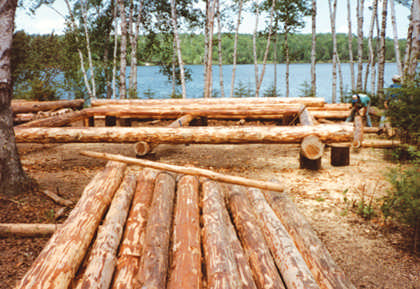 Linda Vukson
Linda Vukson  Linda Vukson
Linda Vukson  Linda Vukson
Linda Vukson  Linda Vukson
Linda Vukson 



